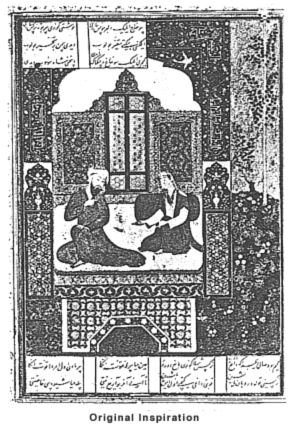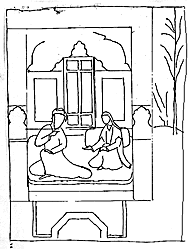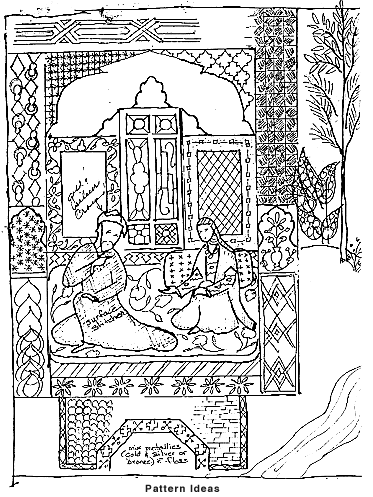Part II by Lois Caron
In Part I (Developing Your
Creative "Side") we talked about some ways to develop
your creativity through the use of pattern, texture, stitches and color.
How do all of these factors work together to form a cohesive piece of needlework
-- one which makes a statement?
First, you need to choose a project. Then you'll be ready to PLAN your approach to it. Your own design, a handpainted needlepoint design,
a commercial kit, a charted pattern, a workshop project -- all are OK.
If this is the first time you've gone off in your own direction, try something
reasonably small, but fairly complex. You'll find that as you get into
this, ideas generate more ideas and on and on.
Make three or more outline tracings of your design. If you have a photocopier
handy, that's all the easier. If you're working from a chart with symbols
or a printed pattern with lots of shading, trace the important shapes without
worrying about the smaller details.
On one tracing doodle with patterns as in the example below. If no ideas
come to mind right away, here are some ways to get started:
1) refer to your original source and see what details you want to preserve
2) refer to pattern or stitchery books, magazines, household items,
etc. Pick out whatever catches your eye or select a pattern at random.
3 ) if you're doing a project to enhance your interior decorating scheme,
choose one or two details from the room which you'd like to emphasize.
For example, you might select a minor color from an upholstery fabric pattern
to be the background of your piece to add drama and you might do a variation
of a geometric motif in the draperies or on a flowerpot as a border for
a pillow, interpreting it in a very textural manner through the stitches
and threads you choose.
3) just start doodling. We've all done this at school or talking on
the telephone.
 --- ---
Whenever you come up with something you think has possibilities, try
to interpret it in as many ways as you can on a scrap piece of canvas or
fabric, using the techniques we've discussed earlier. Try various color
combinations, different stitch techniques and build on the original pattern,
changing it an as many was as you can imagine. Below is a doodle canvas
showing what can result.
If you come up with one or more ideas you like, but don't choose to
use in your project, make notes for future reference, including the canvas
or fabric size, materials used, etc. You now have the beginning of an idea
notebook which can become an invaluable reference source and which should
provide you with inspiration for more creativity later on.
On your second tracing make color notes or fill in your design with
markers to get an idea of the overall color feeling you wish to convey.
Even if you're working on a ready-made piece you may wish to try this to
test any changes you have in mind.

On tracing #3 make notes about which patterns you feel will fit in each
area and how you would interpret that pattern -- basketweave, cross stitch,
diaper pattern, freeform pattern, surface embroidery, darning pattern,
a combination, etc. Also include notes on the materials you might use.
A metallic or synthetic might give just the contrast you need, even without
changing colors, or a hand-dyed variegated thread may give a whole new
dimension to the piece.

Now you've got more ideas than you can use. The hardest task is to be
selective in making decisions. Try everything that comes to mind, but use
only what will work well. Stitchery, pattern and color should enhance a
design, not override it.
ATTITUDE
It isn't necessary to design your own needlewrok to be creative. There
are many, many talented and excellent designers whose work can be a jumping
off point for your own creativeness. Start with what they have done and
go beyond the familiar and try new ways of thinking and doing. Don't forget
what you've learned in the past and welcome every opportunity to learn
new techniques, but don't be bound by rules and restrictions. Use your
knowledge as a foundation on which to build. By trying new things, even
those you don't like, you can improve on those you do like. Experimentation
leads to new ideas and often you'll find that you like a technique after
all. You'll discover that you can do things you never thought possible.
We've only touched the tip of the iceberg here. Keep up the momentum
and go on and apply the concepts you've learned to other experiments with
pattern, texture and color. For instance, try a small, simple sketch of
a landscape and develop it into some ideas for seasonal scenes.
Trust yourself. You'll be pleased with the results.
Our online class this month continues
the theme of developing your own design sense. We've started with a geometric
motif -- a six-pointed star -- and show some ways to develop the design.
Try your hand at the pattern and see where your explorations lead you.
COPYRIGHT NOTICE: No part of this feature story nor the included designs/charts
can be reproduced or distributed in any form (including electronic) or
used as a teaching tool without the prior written permission of the CARON
Collection Ltd. or the featured designers. One time reproduction privileges
provided to our web site visitors for and limited to personal use only.
|


 ---
---